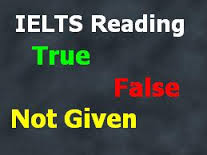 In this question you see a number of statements and you must decide if they are true, false or not given. You must write ‘True’, ‘False’ or ‘Not given’ in the answer sheet.
In this question you see a number of statements and you must decide if they are true, false or not given. You must write ‘True’, ‘False’ or ‘Not given’ in the answer sheet.
If you can find exactly the same sort of information in the text (the words might be different but the meaning is absolutely the same), it means that the statement is TRUE.
If the information in the text contradicts the statement, it means that it’s FALSE. A good way to check this is to transform the statement into a question, and ask yourself: “Does the text say this?”.
For example, your statement might be something like “The research indicates that nowadays more young people prefer digital learning to traditional learning”. You should ask yourself a series of questions to get it right: Is research mentioned at all? If yes, does it show that more people prefer digital learning to traditional learning? If yes, is it about nowadays? and so on. Make sure you ask a question about each particular word in this sentence. If at some point, you say “no”, and find the information that contradicts the statement, then it is false.
For example, if in the text you read something like “In his research, Professor Smith discovered that digital learning is gaining popularity with older generation of people, and replacing traditional learning”. Everything is similar apart from 1 word. The text tells you about older people, but the statement is about young people. So when you ask yourself: “Is the research about young people?” Your answer will be: “No, it’s about older people” (the information in the text contradicts the statement).
But this question is more tricky than that. It’s not only about true or false. The information may not be given, or may partly be not given. Let’s take the same example about Professor Smith. The sentence in the text may be “In his research, Professor Smith discovered that digital learning is gaining popularity with younger generation of people”. This seems true, but it misses out a part of the information in the statement. It doesn’t mention traditional learning at all. We see that digital learning is gaining popularity with young people. But the text doesn’t say that young people prefer digital learning over traditional learning. That is why you write NOT GIVEN.